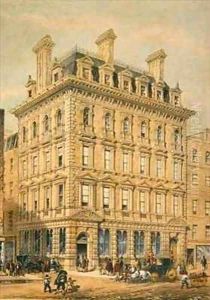Day & Son Paintings
Day & Son was not a single artist but rather a prominent lithographic firm in 19th-century Britain, known for its high-quality prints and illustrations. The firm was established by William Day the elder (1797–1845) and was continued by his son, William Day the younger (1823–1906). The 'Son' in the company's name refers to the younger Day, who joined the business in 1845, the same year his father died.
The firm began its operations under the name Day & Haghe, as William Day the elder originally partnered with Louis Haghe in 1831. They specialized in lithography, which was a relatively new printmaking technology at the time. The collaboration between Day and Haghe was successful, and they became Lithographers to the Queen in 1838. This prestigious appointment helped them secure a variety of high-profile projects, including the production of large-scale prints and illustrated books.
After the departure of Louis Haghe in 1852, the company continued as Day & Son. The firm expanded its operation, becoming the largest lithographic establishment in London. They were known for their technical innovation and artistic quality, producing a wide range of works from fine art prints to commercial advertisements, including the famous series of plates for 'The Great Exhibition of the Works of Industry of All Nations' in 1851.
William Day the younger continued to run the business until the late 19th century. Under his leadership, Day & Son also published educational material and illustrated books, contributing to the Victorian era's burgeoning print culture. The firm's work captured the period's aesthetic and technological advancements, and their prints served as a medium for bringing art to a broader public.
The firm's prominence waned towards the end of the century, and it eventually ceased operating in 1893. Despite this, the legacy of Day & Son's contribution to lithography and Victorian art remains significant. Their prints are valuable not only for their aesthetic quality but also as historical documents that record the era's cultural, technological, and social developments.
